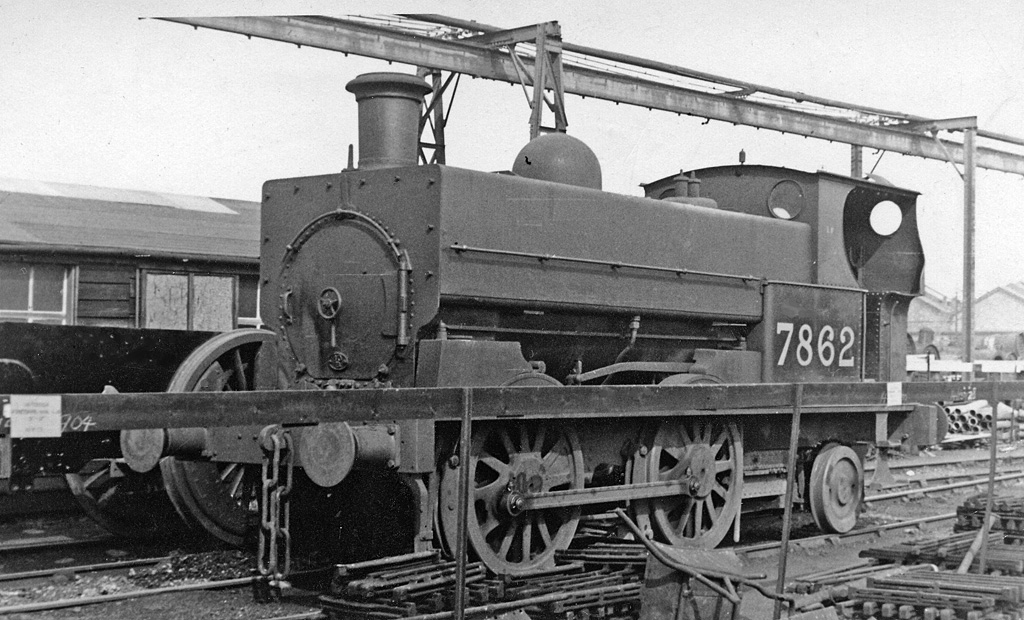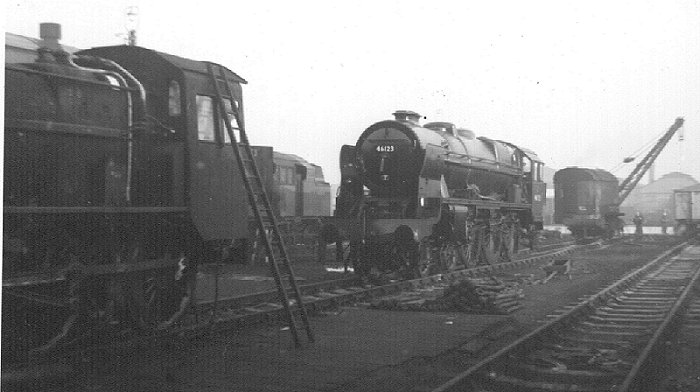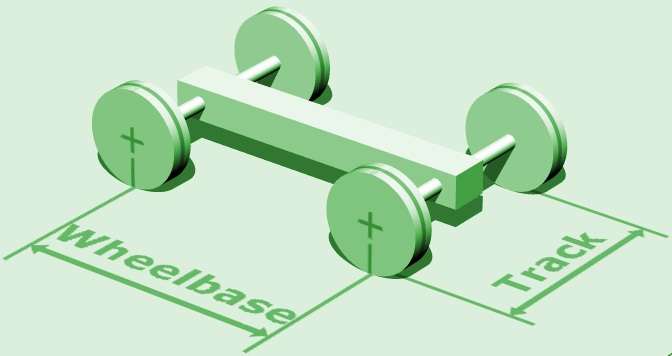|
LNWR Dock Tank
The LNWR 317 class, (also known as Saddle Tank Shunter, Dock Tank or Bissel Tank) consisted of a class of 20 square saddle-tanked steam locomotives built by the London and North Western Railway at their Crewe Works between 1896 and 1901. They had a very short coupled wheelbase, with a trailing Bissel truck to carry weight. History They were built in three batches of 1, 9 and 10; their first running number was chosen at random from the numbers left vacant by locomotives that had been transferred to the duplicate list. This fate was almost immediately suffered by the 317 class – after only one or two months in service. All passed to the London, Midland and Scottish Railway in 1923, who initially allocated them the numbers 6400–6419 in the passenger tank sequence. Only five (6402/03/07/14/18) had been renumbered before the numbers were changed to 7850–7869 in 1927, thus moving them into the goods and shunting tanks. The LMS changed their power classification from 1P to 0F a ... [...More Info...] [...Related Items...] OR: [Wikipedia] [Google] [Baidu] |
Crewe Works
Crewe Works is a British railway engineering facility located in the town of Crewe, Cheshire. The works, which was originally opened by the Grand Junction Railway in 1840, employed around 7,000 to 8,000 workers at its peak. In the 1980s, a lot of the engineering works were closed. Much of the site has been redeveloped but the remaining parts are owned and operated by French-owned multinational rolling stock manufacturer, Alstom SA. During the late 19th century, the London and North Western Railway used Crewe Works to produce many famous locomotives such as the Webb Jumbo class and the compounds, the Whale Experiment and Precursor classes, and the Bowen-Cooke Claughtons. In particular, Whale's 1912 superheated G1 Class developed from a locomotive introduced by Webb in 1892, lasted, in many cases until 1964, near the end of steam in 1968. After grouping, the works were taken over by London, Midland and Scottish Railway which was the successor to the LNWR. It was during ... [...More Info...] [...Related Items...] OR: [Wikipedia] [Google] [Baidu] |
0-4-2ST
Under the Whyte notation for the classification of steam locomotives, represents the wheel arrangement with no leading wheels, four powered and coupled driving wheels on two axles and two trailing wheels on one axle. While the first locomotives of this wheel arrangement were tender engines, the configuration was later often used for tank engines, which is noted by adding letter suffixes to the configuration, such as for a conventional side-tank locomotive, for a saddle-tank locomotive, for a well-tank locomotive and for a rack-equipped tank locomotive. The arrangement is sometimes known as Olomana after a Hawaiian 0-4-2 locomotive of 1883. Overview The earliest recorded locomotives were three goods engines built by Robert Stephenson and Company for the Stanhope and Tyne Railway in 1834. The first locomotive built in Germany in 1838, the '' Saxonia'', was also an . In the same year Todd, Kitson & Laird built two examples for the Liverpool and Manchester Railway, one of ... [...More Info...] [...Related Items...] OR: [Wikipedia] [Google] [Baidu] |
London And North Western Railway
The London and North Western Railway (LNWR, L&NWR) was a British railway company between 1846 and 1922. In the late 19th century, the L&NWR was the largest joint stock company in the United Kingdom. In 1923, it became a constituent of the London, Midland and Scottish (LMS) railway, and, in 1948, the London Midland Region of British Railways: the LNWR is effectively an ancestor of today's West Coast Main Line. History The company was formed on 16 July 1846 by the amalgamation of the Grand Junction Railway, London and Birmingham Railway and the Manchester and Birmingham Railway. This move was prompted, in part, by the Great Western Railway's plans for a railway north from Oxford to Birmingham. The company initially had a network of approximately , connecting London with Birmingham, Crewe, Chester, Liverpool and Manchester. The headquarters were at Euston railway station. As traffic increased, it was greatly expanded with the opening in 1849 of the Great Hall, designed by P ... [...More Info...] [...Related Items...] OR: [Wikipedia] [Google] [Baidu] |
London, Midland And Scottish Railway
The London, Midland and Scottish Railway (LMSIt has been argued that the initials LMSR should be used to be consistent with LNER, GWR and SR. The London, Midland and Scottish Railway's corporate image used LMS, and this is what is generally used in historical circles. The LMS occasionally also used the initials LM&SR. For consistency, this article uses the initials LMS.) was a British railway company. It was formed on 1 January 1923 under the Railways Act of 1921, which required the grouping of over 120 separate railways into four. The companies merged into the LMS included the London and North Western Railway, Midland Railway, the Lancashire and Yorkshire Railway (which had previously merged with the London and North Western Railway on 1 January 1922), several Scottish railway companies (including the Caledonian Railway), and numerous other, smaller ventures. Besides being the world's largest transport organisation, the company was also the largest commercial enterprise ... [...More Info...] [...Related Items...] OR: [Wikipedia] [Google] [Baidu] |
British Railways
British Railways (BR), which from 1965 traded as British Rail, was a state-owned company that operated most of the overground rail transport in Great Britain from 1948 to 1997. It was formed from the nationalisation of the Big Four British railway companies, and was privatised in stages between 1994 and 1997. Originally a trading brand of the Railway Executive of the British Transport Commission, it became an independent statutory corporation in January 1963, when it was formally renamed the British Railways Board. The period of nationalisation saw sweeping changes in the railway. A process of dieselisation and electrification took place, and by 1968 steam locomotives had been entirely replaced by diesel and electric traction, except for the Vale of Rheidol Railway (a narrow-gauge tourist line). Passengers replaced freight as the main source of business, and one-third of the network was closed by the Beeching cuts of the 1960s in an effort to reduce rail subsidies. On privatis ... [...More Info...] [...Related Items...] OR: [Wikipedia] [Google] [Baidu] |
London Midland Region Of British Railways
The London Midland Region (LMR) was one of the six regions created on the formation of the nationalised British Railways (BR), and initially consisted of ex-London, Midland and Scottish Railway (LMS) lines in England, Wales and Northern Ireland. The region was managed first from buildings adjacent to Euston station, and later from Stanier House in Birmingham. It existed from the creation of BR in 1948, ceased to be an operating unit in its own right in the 1980s, and was wound up at the end of 1992. Territory At its inception, the LMR's territory consisted of ex-LMS lines in England and Wales. The Mersey Railway, which had avoided being "Grouped" with the LMS in 1923, also joined the LMR. The LMR's territory principally consisted of the West Coast Main Line (WCML), the Midland Main Line (MML) south of Carlisle, and the ex-Midland Cross Country route from Bristol to Leeds. During the LMR's existence there were a number of transfers of territory to and from other regions. T ... [...More Info...] [...Related Items...] OR: [Wikipedia] [Google] [Baidu] |
Wheelbase
In both road and rail vehicles, the wheelbase is the horizontal distance between the centers of the front and rear wheels. For road vehicles with more than two axles (e.g. some trucks), the wheelbase is the distance between the steering (front) axle and the centerpoint of the driving axle group. In the case of a tri-axle truck, the wheelbase would be the distance between the steering axle and a point midway between the two rear axles. Vehicles The wheelbase of a vehicle equals the distance between its front and rear wheels. At equilibrium, the total torque of the forces acting on a vehicle is zero. Therefore, the wheelbase is related to the force on each pair of tires by the following formula: :F_f = mg :F_r = mg where F_f is the force on the front tires, F_r is the force on the rear tires, L is the wheelbase, d_r is the distance from the center of mass (CM) to the rear wheels, d_f is the distance from the center of mass to the front wheels (d_f + d_r = L), m is the mass ... [...More Info...] [...Related Items...] OR: [Wikipedia] [Google] [Baidu] |
Bissel Truck
A Bissell or Bissel truck (also Bissel bogie or Pony truck) is a single-axle bogie which pivots towards the centre of a steam locomotive to enable it to negotiate curves more easily. Invented in 1857 by and usually then known as a ''pony truck'', it is a very simple and common means of designing a carrying wheel. Name variants A pony truck in railway terminology, is a leading truck with only two wheels. Its invention is generally credited to Bissell, who devised one in 1857 and patented it the following year. Hence the term ''Bissel bogie'', ''Bissel truck'', or ''Bissel axle'' is used in continental Europe. In the UK, the term is Bissell truck.''Spellings" Conservative locomotive builders in Bissell's native |
LMS Locomotive Numbering And Classification
A number of different numbering and classification schemes were used for the locomotives owned by the London, Midland and Scottish Railway (LMS) and its constituent companies; this page explains the principal systems that were used. The following abbreviations for the constituent companies are used on this page: * ''Principal Constituents'' Caledonian Railway (CR), Furness Railway (FR), Glasgow and South Western Railway (GSWR), Highland Railway (HR), Lancashire and Yorkshire Railway (LYR), London and North Western Railway (LNWR), Maryport and Carlisle Railway (MCR), Midland Railway (MR), North London Railway (NLR) and North Staffordshire Railway (NSR) * ''Minor Companies'' Cleator and Workington Junction Railway (C&WJR), Glasgow and Paisley Joint Railway (G&PJR), Knott End Railway (KER), Stratford-upon-Avon and Midland Junction Railway (S&MJR), and Wirral Railway (WR) * ''Later Additions'' Somerset and Dorset Joint Railway (S&DJR) - absorbed October 1936 For information ... [...More Info...] [...Related Items...] OR: [Wikipedia] [Google] [Baidu] |
Crewe Works 8 Geograph-2224108
Crewe () is a railway town and civil parish in the unitary authority of Cheshire East in Cheshire, England. The Crewe built-up area had a total population of 75,556 in 2011, which also covers parts of the adjacent civil parishes of Willaston, Shavington cum Gresty and Wistaston. Crewe is perhaps best known as a large railway junction and home to Crewe Works; for many years, it was a major railway engineering facility for manufacturing and overhauling locomotives, but now much reduced in size. From 1946 until 2002, it was also the home of Rolls-Royce motor car production. The Pyms Lane factory on the west of the town now exclusively produces Bentley motor cars. Crewe is north of London, south of Manchester city centre, and south of Liverpool city centre. History Medieval The name derives from an Old Welsh word ''criu'', meaning 'weir' or 'crossing'. The earliest record is in the Domesday Book, where it is written as ''Creu''. Modern Until the Grand Junction Railway ( ... [...More Info...] [...Related Items...] OR: [Wikipedia] [Google] [Baidu] |
London And North Western Railway Locomotives
London is the capital and largest city of England and the United Kingdom, with a population of just under 9 million. It stands on the River Thames in south-east England at the head of a estuary down to the North Sea, and has been a major settlement for two millennia. The City of London, its ancient core and financial centre, was founded by the Romans as ''Londinium'' and retains its medieval boundaries.See also: Independent city § National capitals The City of Westminster, to the west of the City of London, has for centuries hosted the national government and parliament. Since the 19th century, the name "London" has also referred to the metropolis around this core, historically split between the counties of Middlesex, Essex, Surrey, Kent, and Hertfordshire, which largely comprises Greater London, governed by the Greater London Authority.The Greater London Authority consists of the Mayor of London and the London Assembly. The London Mayor is distinguished from the Lord Mayo ... [...More Info...] [...Related Items...] OR: [Wikipedia] [Google] [Baidu] |





.jpg)



